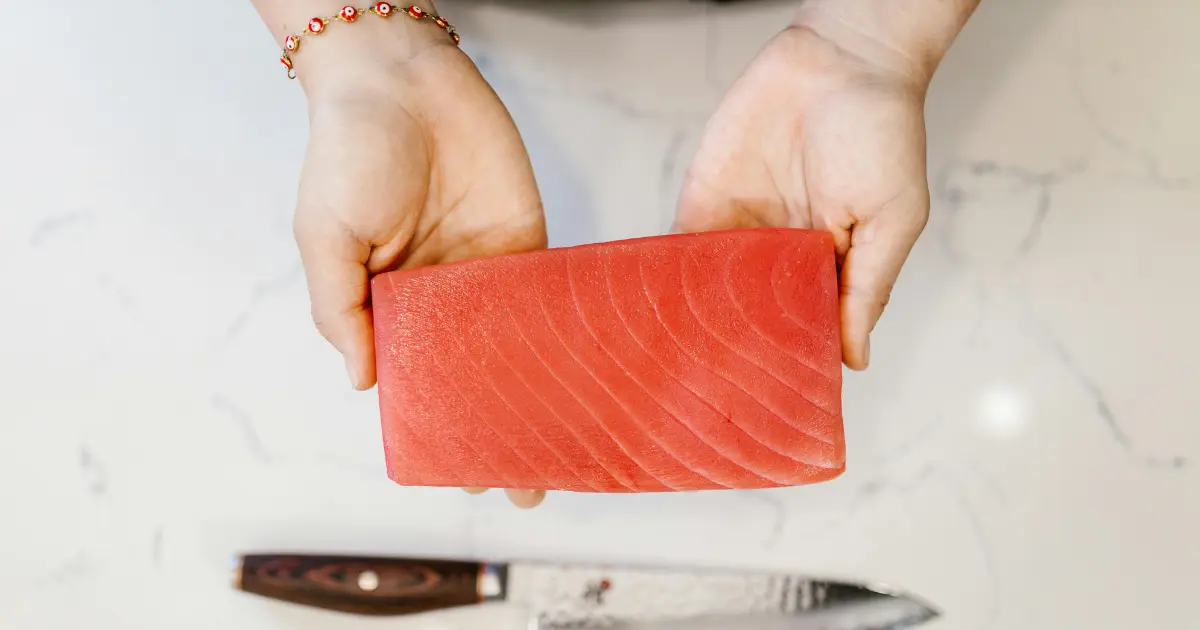Table of Contents
Tuna is a fish loved by many humans, but what about dogs? As a pet owner, you want the best for your furry friend, and it’s natural to wonder, can dogs eat tuna? While it might seem like a simple question, there’s more to feeding tuna to dogs than you might think. In this detailed article, we’ll answer the question, can dogs eat tuna, and explore the health benefits, risks, and proper ways to serve it to ensure your pet stays happy and healthy.
Is Tuna Safe for Dogs?
So, can dogs eat tuna safely? The answer is yes, but with certain precautions. Tuna is generally safe for dogs to eat in moderation, but it’s not something that should become a regular part of their diet. The primary concern is the high mercury content in tuna, especially in larger species like albacore. Mercury, a toxic heavy metal, can accumulate in a dog’s body over time, potentially leading to mercury poisoning.
When asking can dogs eat tuna, it’s important to remember that while the fish offers valuable nutrients, these benefits must be weighed against the potential risks, particularly when feeding canned tuna or raw varieties.
The Nutritional Benefits of Tuna for Dogs
If you’re still wondering, can dogs eat tuna and reap any benefits from it, the answer is absolutely. Tuna is packed with nutrients that are essential for your dog’s health. It’s rich in protein, which is important for muscle growth and tissue repair. Tuna also contains high amounts of omega-3 fatty acids, which can promote a shiny coat, healthy skin, and reduce inflammation, particularly in dogs with arthritis or joint issues.
Additionally, tuna is loaded with essential vitamins and minerals such as:
- Vitamin D: Supports bone health and immune function.
- Vitamin B12: Aids in brain function and energy production.
- Selenium: An antioxidant that protects cells from damage.
So, can dogs eat tuna for its nutritional value? Yes, but it should be done sparingly to prevent potential health risks.

Omega-3 Fatty Acids and Their Benefits for Dogs
One of the most notable benefits of feeding tuna to dogs is its rich content of omega-3 fatty acids. These healthy fats are crucial for dogs, just as they are for humans. Omega-3s help reduce inflammation, support heart health, and improve cognitive function. For dogs with skin conditions, allergies, or joint problems, omega-3s can be particularly beneficial.
When you ask, can dogs eat tuna, and benefit from these fatty acids, the answer is a resounding yes—but with caution due to the risks associated with overconsumption, which we’ll discuss next.
Risks of Feeding Tuna to Dogs
While tuna can be a nutritious treat for your dog, there are significant risks associated with it, especially if it’s not fed in moderation. The two biggest concerns pet owners face when they wonder, can dogs eat tuna, are mercury levels and added sodium in canned tuna.
Mercury in Tuna: Why It Matters
Mercury is a naturally occurring metal found in the environment, but it accumulates in larger fish like tuna. Mercury poisoning is a serious issue that can affect both humans and animals. When too much mercury builds up in a dog’s body, it can lead to symptoms such as tremors, difficulty walking, seizures, and vomiting.
So, when asking can dogs eat tuna, remember that while a small amount of tuna won’t immediately cause harm, regular consumption can lead to mercury toxicity over time. To minimize the risk, opt for smaller types of tuna, such as skipjack, which tend to have lower mercury levels.

Salt in Canned Tuna: A Hidden Danger
Another risk to consider when asking can dogs eat tuna is the sodium content, especially in canned varieties. Many canned tuna products are packed in brine or oil and contain high levels of salt. Too much sodium can be harmful to your dog, potentially causing dehydration, high blood pressure, or even salt poisoning in extreme cases.
If you’re giving your dog canned tuna, always choose a product that is packed in water with no added salt. Rinse the tuna before serving to remove any excess sodium.
How Much Tuna Can Dogs Eat?
You might now be wondering, can dogs eat tuna, and if so, how much is safe? As with most foods, moderation is key. A small portion of tuna once in a while can be a great treat for your dog, but it should not replace their regular dog food. The amount of tuna your dog can safely eat depends on their size. A general guideline is to offer no more than a tablespoon of tuna for every 20 pounds of body weight, and only on occasion.
Avoid making tuna a daily or even weekly part of your dog’s diet. Instead, treat it as an occasional snack to prevent any potential health issues from arising, such as mercury buildup or sodium overload.
Fresh Tuna vs. Canned Tuna: Which is Better for Dogs?
If you’ve ever found yourself asking can dogs eat tuna and debating between fresh and canned options, you’re not alone. Both fresh and canned tuna have their pros and cons when it comes to feeding them to dogs.
- Fresh Tuna: Contains no added preservatives or sodium, making it a cleaner option. However, it can be more expensive and requires proper cooking to avoid harmful bacteria.
- Canned Tuna: Convenient and easily accessible, but it often contains added salt or oil. If choosing canned tuna, make sure it’s packed in water with no added salt.
So, can dogs eat tuna from a can? Yes, but be sure to choose wisely to avoid harmful additives.

Which Type of Canned Tuna is Safe for Dogs?
When choosing canned tuna for your dog, always select a type that is packed in water with no added salt. Flavored or spiced varieties should be avoided, as they may contain ingredients that are toxic to dogs. Additionally, rinse the tuna to remove any residual salt or oil before serving.
If you’re asking, can dogs eat tuna from the grocery store shelf, the answer is yes—but only if you pick the right type and prepare it properly.
How to Safely Serve Tuna to Your Dog
Now that we’ve answered the question, can dogs eat tuna, let’s talk about how to safely serve it to your pet. First, make sure the tuna is fully cooked—raw tuna can contain parasites that are harmful to dogs. When preparing tuna, avoid adding any seasonings, oils, or spices, as these can be harmful.
Here’s a simple way to serve tuna to your dog:
- Cook the tuna thoroughly (boiling or baking is best).
- Flake it into small pieces.
- Mix it with your dog’s regular food or offer it as a small standalone treat.
Remember, can dogs eat tuna cooked? Yes, and this is the safest way to serve it to avoid any health risks.
Alternatives to Tuna for Dogs
If you’re concerned about the risks associated with feeding your dog tuna, there are plenty of other fish that are safer and still packed with nutrients. Some great alternatives include:
- Salmon: Rich in omega-3 fatty acids and lower in mercury than tuna.
- Sardines: Small, nutrient-dense fish that are low in mercury and high in healthy fats.
- Mackerel: Another good source of omega-3s, but with a lower mercury content than tuna.
So, can dogs eat tuna? Yes, but if you’re worried about mercury or sodium, these alternatives are great options for providing your dog with a healthy source of protein and omega-3s.

Signs of Tuna Overconsumption in Dogs
If you’re feeding your dog tuna too often, there are several signs of overconsumption to watch out for. These symptoms could indicate mercury poisoning or excessive sodium intake:
- Vomiting
- Diarrhea
- Loss of coordination
- Tremors or seizures
- Excessive thirst and urination
If you notice any of these symptoms and suspect they’re related to feeding your dog tuna, contact your vet immediately.
What to Do if Your Dog Eats Too Much Tuna
If your dog accidentally eats too much tuna, the first step is to monitor them for any symptoms of mercury or salt poisoning. In most cases, a small amount of tuna won’t cause any harm, but if your dog consumes a large portion or shows signs of distress, call your vet for advice. Your vet may recommend supportive care, such as IV fluids to help flush out excess sodium or toxins.
So, can dogs eat tuna without worry? Yes, but overconsumption can lead to serious health issues, so it’s important to stick to small portions and limit how often you serve it.
Conclusion
In conclusion, can dogs eat tuna? Yes, but moderation is key. Tuna offers a wealth of nutritional benefits, including protein and omega-3 fatty acids, but it also comes with risks such as mercury poisoning and excessive sodium intake. By choosing the right type of tuna, serving it in small portions, and making sure it’s fully cooked, you can safely give your dog this fish as an occasional treat. Always remember that balance is essential, and it’s best to consult your vet if you have any concerns about your dog’s diet.
If you’re curious about other foods for your dog, you might also want to learn about can dogs eat raw chicken? and can dogs eat shrimp?, which also offer important insights on safe food options for your pet.
FAQs
- Can dogs eat tuna every day?
No, dogs should not eat tuna every day. It’s best to serve tuna occasionally due to the risks of mercury poisoning and high sodium levels in canned tuna. - Can dogs eat raw tuna?
No, raw tuna should be avoided because it can contain harmful parasites that may affect your dog’s health. - How often can I give my dog tuna?
Tuna should only be an occasional treat—no more than once a week to reduce the risk of mercury accumulation in your dog’s system. - Is tuna in oil safe for dogs?
It’s best to avoid tuna packed in oil, as the fat content can be too rich for dogs and may lead to digestive issues. - What’s a safer fish option than tuna for dogs?
Salmon or sardines are safer alternatives to tuna, as they have lower mercury levels and are still packed with healthy omega-3 fatty acids.





